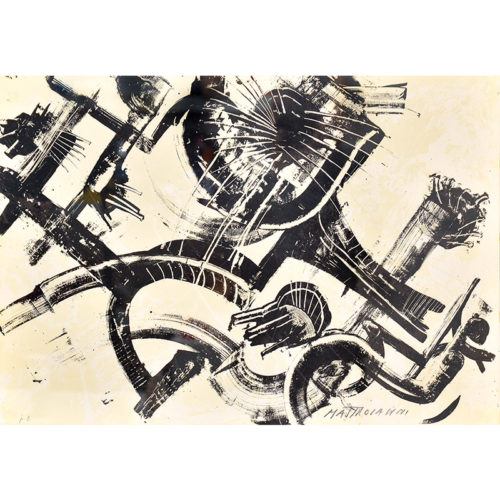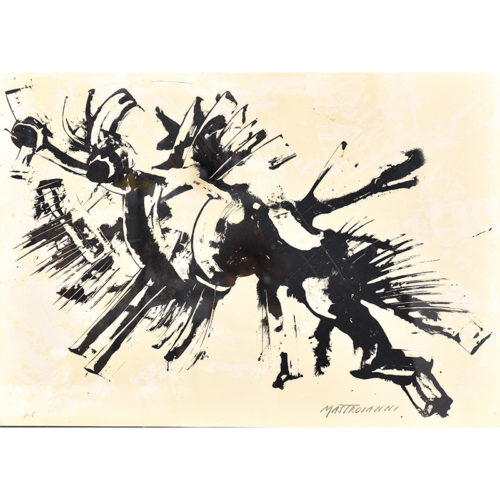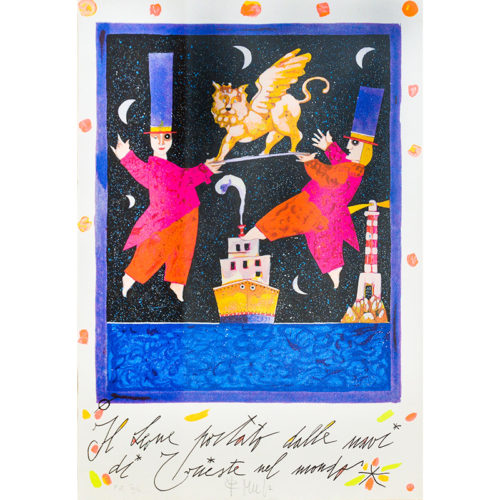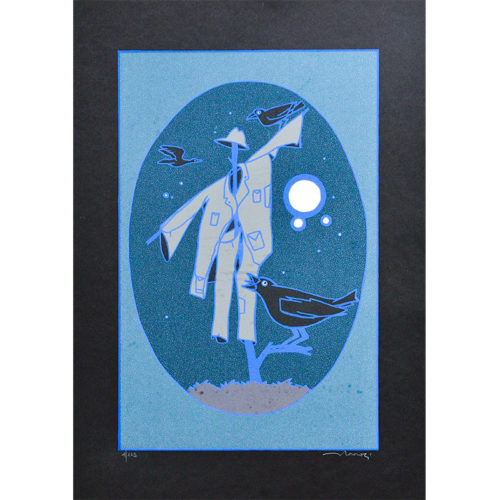-
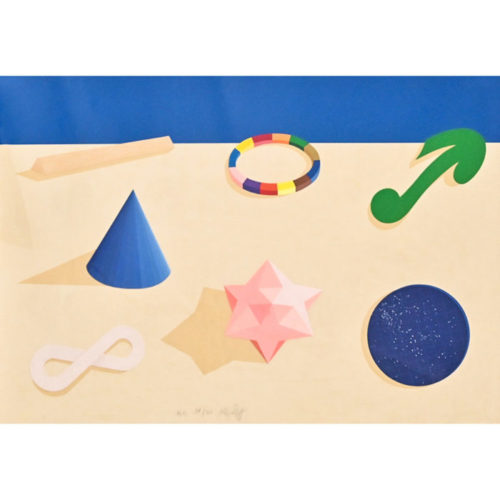 Screen printing and collage on paper by Lucio Del Pezzo, limited edition of only 20 copies. In excellent condition. Lucio Del Pezzo (Naples 1933 - Milan 2020) was an Italian artist, painter and sculptor. He is one of the founders of “Gruppo 58”, which has always been very close to other avant-gardes, such as Enrico Baj's Nuclear Movement, the Spoor Movement of Monaco, Phases of Paris and Boa of Buenos Aires. His works from the period 1958-1960 featured assemblages of various objects, including fragments of popular prints and images. In 1960 he moved to Paris, then to Milan, where several monographic exhibitions have been dedicated to him. The first one dates back to 1974. Starting from 1962 Del Pezzo has created his typical repertoire of "paintings" or "sculptures", made of monochrome geometric panels, on which shelves or hollowed out concavities are inserted, which support regular geometric objects, sometimes very colorful. Lucio del Pezzo's production focuses on the use of common objects that, enriched with different materials, cross the boundary between painting and sculpture. His style is also characterized by a rapprochement with metaphysical atmospheres, while the playful sense and irony behind each work is inspired by the Dadaist movement. Period: 1970s Measurements: In frame H 73 x W 103 x D 3.5 / Serigraphy H 70 x W 100 cm
Screen printing and collage on paper by Lucio Del Pezzo, limited edition of only 20 copies. In excellent condition. Lucio Del Pezzo (Naples 1933 - Milan 2020) was an Italian artist, painter and sculptor. He is one of the founders of “Gruppo 58”, which has always been very close to other avant-gardes, such as Enrico Baj's Nuclear Movement, the Spoor Movement of Monaco, Phases of Paris and Boa of Buenos Aires. His works from the period 1958-1960 featured assemblages of various objects, including fragments of popular prints and images. In 1960 he moved to Paris, then to Milan, where several monographic exhibitions have been dedicated to him. The first one dates back to 1974. Starting from 1962 Del Pezzo has created his typical repertoire of "paintings" or "sculptures", made of monochrome geometric panels, on which shelves or hollowed out concavities are inserted, which support regular geometric objects, sometimes very colorful. Lucio del Pezzo's production focuses on the use of common objects that, enriched with different materials, cross the boundary between painting and sculpture. His style is also characterized by a rapprochement with metaphysical atmospheres, while the playful sense and irony behind each work is inspired by the Dadaist movement. Period: 1970s Measurements: In frame H 73 x W 103 x D 3.5 / Serigraphy H 70 x W 100 cm -
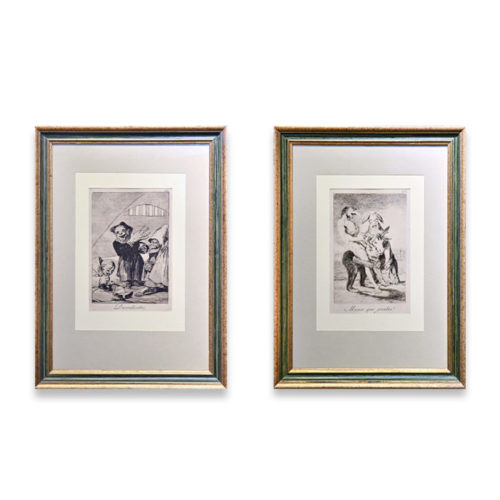 "Duendecitos" etching / aquatint by Francisco Goya y Lucientes (Fuentedos, Spain 1746 - Bordeaux 1828). Original etching - Plate 49 of the "Los caprichos" series - V edition on XII. Bibliography: Harris 84; Delteil 86. Provenance Vianzone, Turin. Dimensions in mm: 190 x 130 "Miren que grabes!" etching / aquatint by Francisco Goya y Lucientes (Fuentedos, Spain 1746 - Bordeaux 1828). Original etching - Plate 63 of the "Los caprichos" series - V edition on XII. Bibliography: Harris 98; Delteil 100. Provenance Vianzone, Turin. Dimensions in mm: 187 x 122 The Capricci represent the most famous series of engravings by the Spanish master: 80 plates including etchings and aquatints of large format, made in 1799. These are plates that give rise to imaginative, pungent and grotesque representations that are affected, on a stylistic level, by an Italian influence due to the long stay in Rome in 1770. The main theme is the description of the evils of the world, from deceptions to prejudices, up to the lies of the Spanish society of the years in which Goya himself lived, in a heated controversy towards the clergy and the nobility. At the time of their publication, the drawings caused a sensation, precisely due to the fact that numerous notables of the time were recognized in them. So much was the clamor that even the Holy Inquisition had to intervene, to avoid the publication of those prints deemed excessive and blasphemous. This was probably what determined the poor success of I Capricci, so that the painter was forced to sell the entire first print run to King Charles IV, in exchange for a scholarship for his son Javier. The success of the series increased with the second edition of 1855, until it became one of the most important and celebrated graphic works in the history of art. Period: Second half of the 19th century Measurements: In frame H 45 x W 33 x D 2.5 cm / H 19 x W 13 cm // In frame H 44 x W 32.5 x D 2.5 cm / H 18.7 x W 12.2 cm
"Duendecitos" etching / aquatint by Francisco Goya y Lucientes (Fuentedos, Spain 1746 - Bordeaux 1828). Original etching - Plate 49 of the "Los caprichos" series - V edition on XII. Bibliography: Harris 84; Delteil 86. Provenance Vianzone, Turin. Dimensions in mm: 190 x 130 "Miren que grabes!" etching / aquatint by Francisco Goya y Lucientes (Fuentedos, Spain 1746 - Bordeaux 1828). Original etching - Plate 63 of the "Los caprichos" series - V edition on XII. Bibliography: Harris 98; Delteil 100. Provenance Vianzone, Turin. Dimensions in mm: 187 x 122 The Capricci represent the most famous series of engravings by the Spanish master: 80 plates including etchings and aquatints of large format, made in 1799. These are plates that give rise to imaginative, pungent and grotesque representations that are affected, on a stylistic level, by an Italian influence due to the long stay in Rome in 1770. The main theme is the description of the evils of the world, from deceptions to prejudices, up to the lies of the Spanish society of the years in which Goya himself lived, in a heated controversy towards the clergy and the nobility. At the time of their publication, the drawings caused a sensation, precisely due to the fact that numerous notables of the time were recognized in them. So much was the clamor that even the Holy Inquisition had to intervene, to avoid the publication of those prints deemed excessive and blasphemous. This was probably what determined the poor success of I Capricci, so that the painter was forced to sell the entire first print run to King Charles IV, in exchange for a scholarship for his son Javier. The success of the series increased with the second edition of 1855, until it became one of the most important and celebrated graphic works in the history of art. Period: Second half of the 19th century Measurements: In frame H 45 x W 33 x D 2.5 cm / H 19 x W 13 cm // In frame H 44 x W 32.5 x D 2.5 cm / H 18.7 x W 12.2 cm -
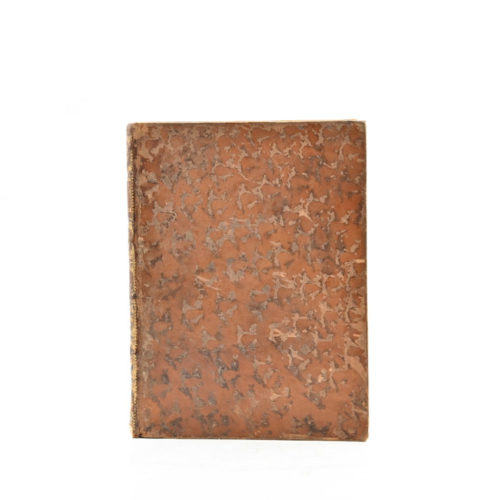
ON THE ANCIENT CONDITION OF THE VERCELLI AREA AND THE ANCIENT VILLAGE OF SANTIA'.
DISSERTATION BY JACOPO DURANDI DEDICATED TO HIS ROYAL HIGHNESS BENEDETTO MARIA MAURIZIO DI SAVOJA DUKE OF CHABLAIS. IN TURIN, 1766.
Rare first edition. Very well preserved.Period: 1766
Measurements: H 25,5 x 19,5 x 2,5 cm
-
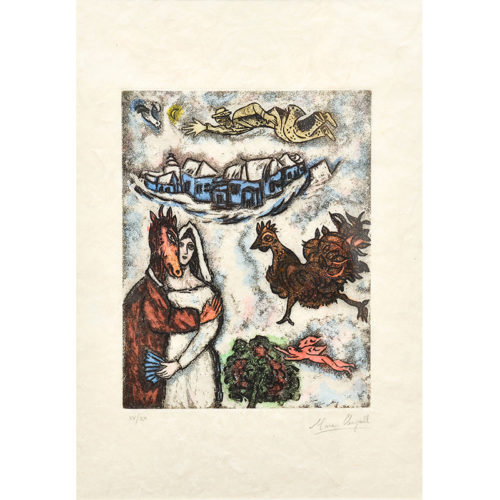 Lithograph on Japanese paper by Marc Chagall (Lëzna, 7 July 1887 - Saint-Paul-de-Vence, 28 March 1985), was a French Russian-born painter of Hasidic Jewish origin. Numbered lithograph (XV / XX) on the bottom left, with the signature on the bottom right.Period: 70s Measurements: In frame H 72.5 x L 53 cm / Sheet H 49 x L 34.5 cm
Lithograph on Japanese paper by Marc Chagall (Lëzna, 7 July 1887 - Saint-Paul-de-Vence, 28 March 1985), was a French Russian-born painter of Hasidic Jewish origin. Numbered lithograph (XV / XX) on the bottom left, with the signature on the bottom right.Period: 70s Measurements: In frame H 72.5 x L 53 cm / Sheet H 49 x L 34.5 cm -
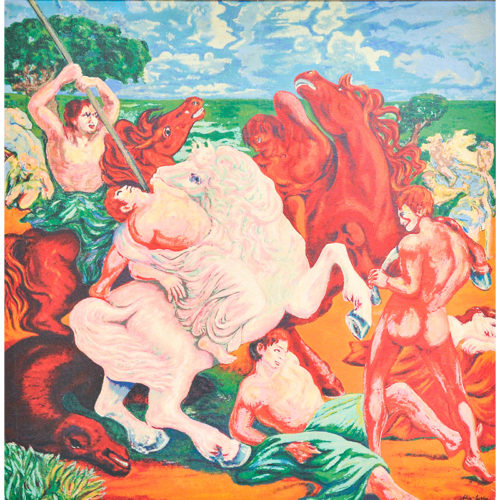 Large original screenprint by Aligi Sassu (1912-2000). SASSU ALIGI. Born on July 17, 1912 in Milan. For his father's Sardinian origins, he spent several years of his childhood in Thiesi (Sassari). His first essays are from 1926. He participated in the futurist movement until 1930; then he broke away. He had contacts in Milan with Edoardo Persico and Raffaele Carrieri; around 1931 he was in opposition to the Italian twentieth century, with Birolli, Manzù, Grosso, Tomea. He exhibited for the first time at the Venetian Biennale in 1928; his first personal is in 1930, at the Galleria del Milione. In 1934 he was in Paris, where he obtained success at the Galerie des Quatre Chemins. Since 1935, after returning to Milan, he has taken part in numerous artistic events. He participated in the first two editions of the Bergamo Prize; at the Sacred Art Exhibition in Bergamo he received the first prize with the work Deposition. He is an etching, lithographer, ceramist; he created works of sculpture, frescoes, stained glass, scenography. In 1957 he created a large cycle of mosaics in the apse of the Chiesa del Carmine in Cagliari; His works have been presented in numerous cities, including abroad: in the U.S.A. in 1933; in London in 1935; in Buenos Aires in 1947; and in Paris, Boston, Lisbon, Bucharest (where an anthology of paintings and graphic works was set up in 1966). Among the major solo shows in Italy, we mention: the one concerning graphics and sculpture carried out in the Galleria Civica di Monza in 1965; that of 1966 in Palermo presented by Salvatore Quasimodo; Period: 20th century Measures: H 163 x L 159 x P 4.5 / Canvas H 151 x L 146 cm
Large original screenprint by Aligi Sassu (1912-2000). SASSU ALIGI. Born on July 17, 1912 in Milan. For his father's Sardinian origins, he spent several years of his childhood in Thiesi (Sassari). His first essays are from 1926. He participated in the futurist movement until 1930; then he broke away. He had contacts in Milan with Edoardo Persico and Raffaele Carrieri; around 1931 he was in opposition to the Italian twentieth century, with Birolli, Manzù, Grosso, Tomea. He exhibited for the first time at the Venetian Biennale in 1928; his first personal is in 1930, at the Galleria del Milione. In 1934 he was in Paris, where he obtained success at the Galerie des Quatre Chemins. Since 1935, after returning to Milan, he has taken part in numerous artistic events. He participated in the first two editions of the Bergamo Prize; at the Sacred Art Exhibition in Bergamo he received the first prize with the work Deposition. He is an etching, lithographer, ceramist; he created works of sculpture, frescoes, stained glass, scenography. In 1957 he created a large cycle of mosaics in the apse of the Chiesa del Carmine in Cagliari; His works have been presented in numerous cities, including abroad: in the U.S.A. in 1933; in London in 1935; in Buenos Aires in 1947; and in Paris, Boston, Lisbon, Bucharest (where an anthology of paintings and graphic works was set up in 1966). Among the major solo shows in Italy, we mention: the one concerning graphics and sculpture carried out in the Galleria Civica di Monza in 1965; that of 1966 in Palermo presented by Salvatore Quasimodo; Period: 20th century Measures: H 163 x L 159 x P 4.5 / Canvas H 151 x L 146 cm -
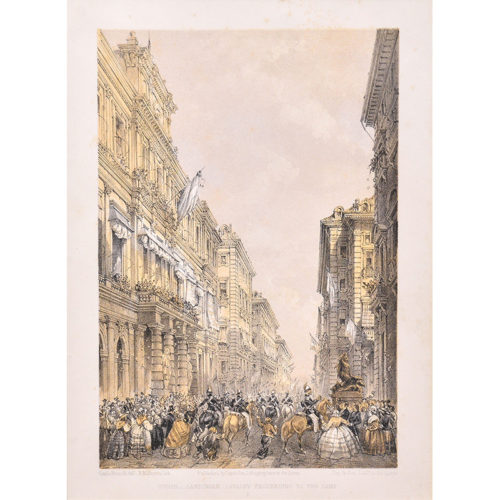 Lithograph by Carlo Bossoli representing the perspective view of the Palazzo di Città and the current via Milano (Turin) in which, in a blaze of cheering crowds, the Piedmontese cavalry leaving for the war parades on 17 April 1859. Signed by the author .Period: 1859 Measurements: H 22.5 x L 15.3 cmPeriod: 1859
Lithograph by Carlo Bossoli representing the perspective view of the Palazzo di Città and the current via Milano (Turin) in which, in a blaze of cheering crowds, the Piedmontese cavalry leaving for the war parades on 17 April 1859. Signed by the author .Period: 1859 Measurements: H 22.5 x L 15.3 cmPeriod: 1859 -
Out of stock
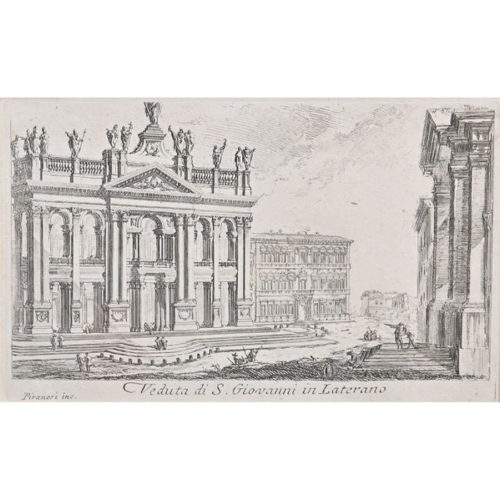 "View of San Giovanni in Laterano" engraving by Giovan Battista Piranesi (Venice 1720 - Rome 1778). 13x20. Etching, circa 1745, signed on the plate. Magnificent proof, with full margins, in perfect condition. Work taken from the "Varie Vedute di Roma Antica, e Moderna. Disegnate e Intagliate da Celebri Autori" printed in Rome "a spese di Fausto Amidei", 1748. Period: about 1745 Measurements: Framed H 30 x W 40,5 x D 1,5 cm/ Engraving H 13 x W 20 cm
"View of San Giovanni in Laterano" engraving by Giovan Battista Piranesi (Venice 1720 - Rome 1778). 13x20. Etching, circa 1745, signed on the plate. Magnificent proof, with full margins, in perfect condition. Work taken from the "Varie Vedute di Roma Antica, e Moderna. Disegnate e Intagliate da Celebri Autori" printed in Rome "a spese di Fausto Amidei", 1748. Period: about 1745 Measurements: Framed H 30 x W 40,5 x D 1,5 cm/ Engraving H 13 x W 20 cm -
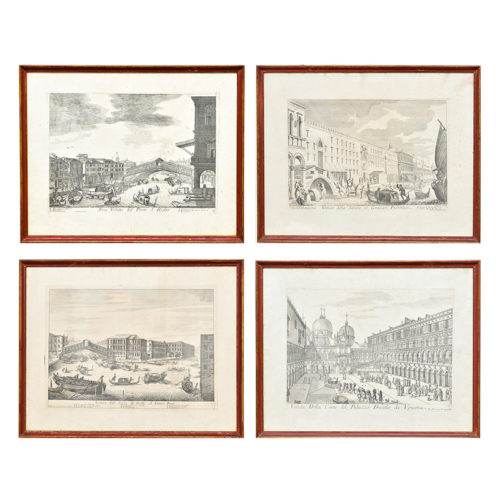 Period: 1717 Measurements: In frame H 53 x L 67 / Paper H 48 x L 61 cm"Venice" - Lithographs by Filippo Vasconi (1687 - 1730) for Domenico Lovisa (1690 - 1750), dating back to 1717. The four lithographs represent:
Period: 1717 Measurements: In frame H 53 x L 67 / Paper H 48 x L 61 cm"Venice" - Lithographs by Filippo Vasconi (1687 - 1730) for Domenico Lovisa (1690 - 1750), dating back to 1717. The four lithographs represent:- "View of the Court of the Doge's Palace in Venice" from The Gran Teatro di Venezia
- "View of the Rialto Island with the Famous Bridge" from The Gran Teatro di Venezia
- "View of Health and Public Granaries" from The Gran Teatro di Venezia
- "Other View of the Rialto Bridge" from The Gran Teatro di Venezia
